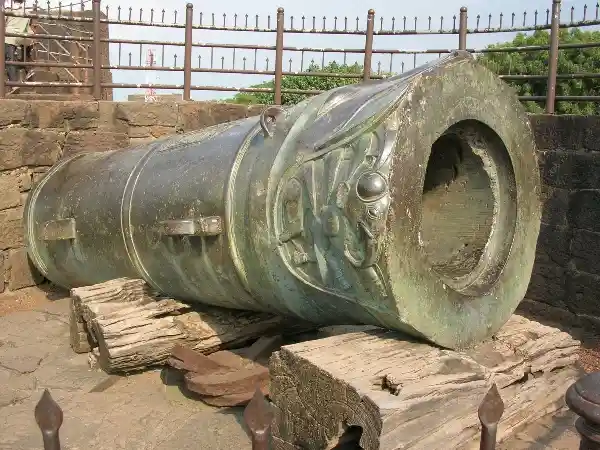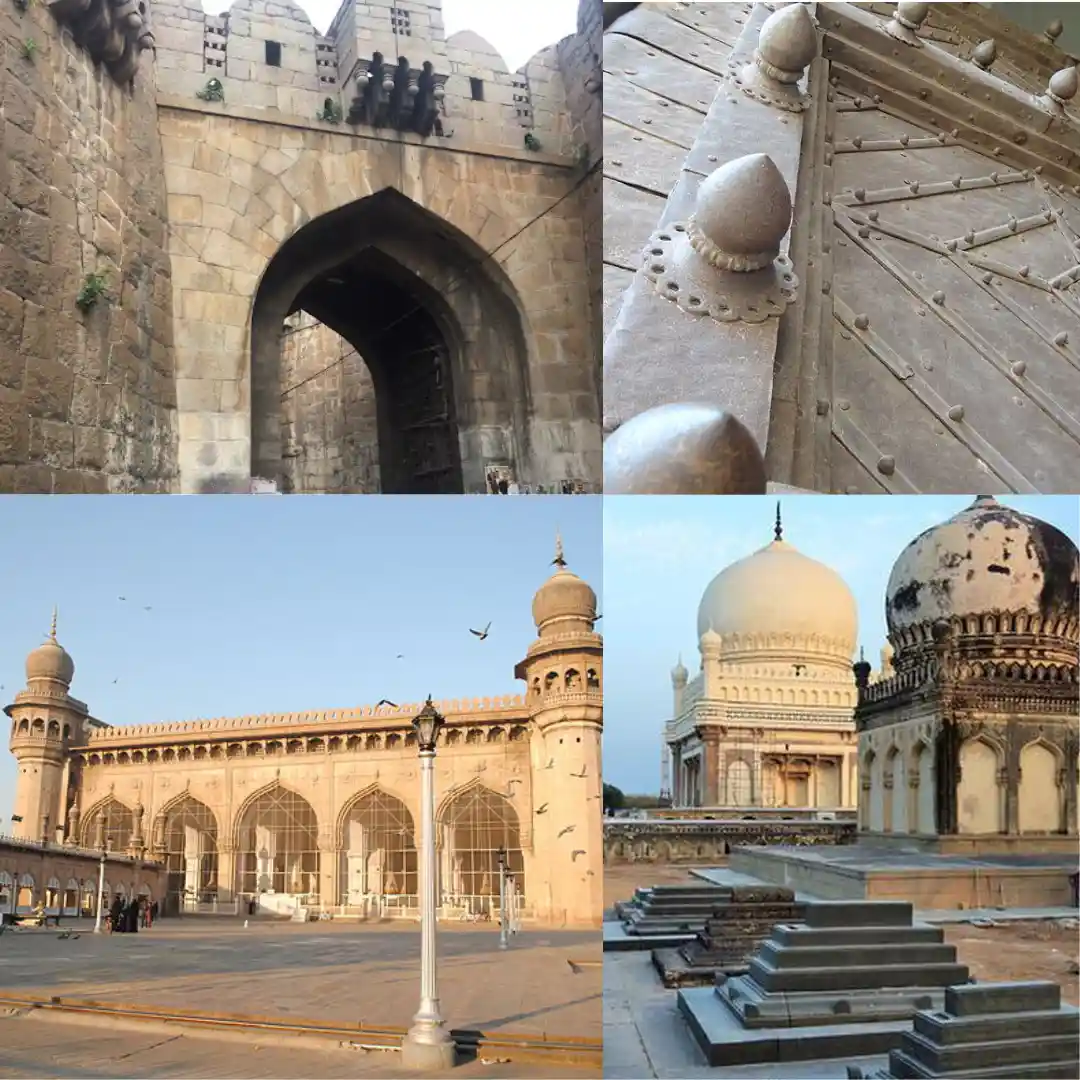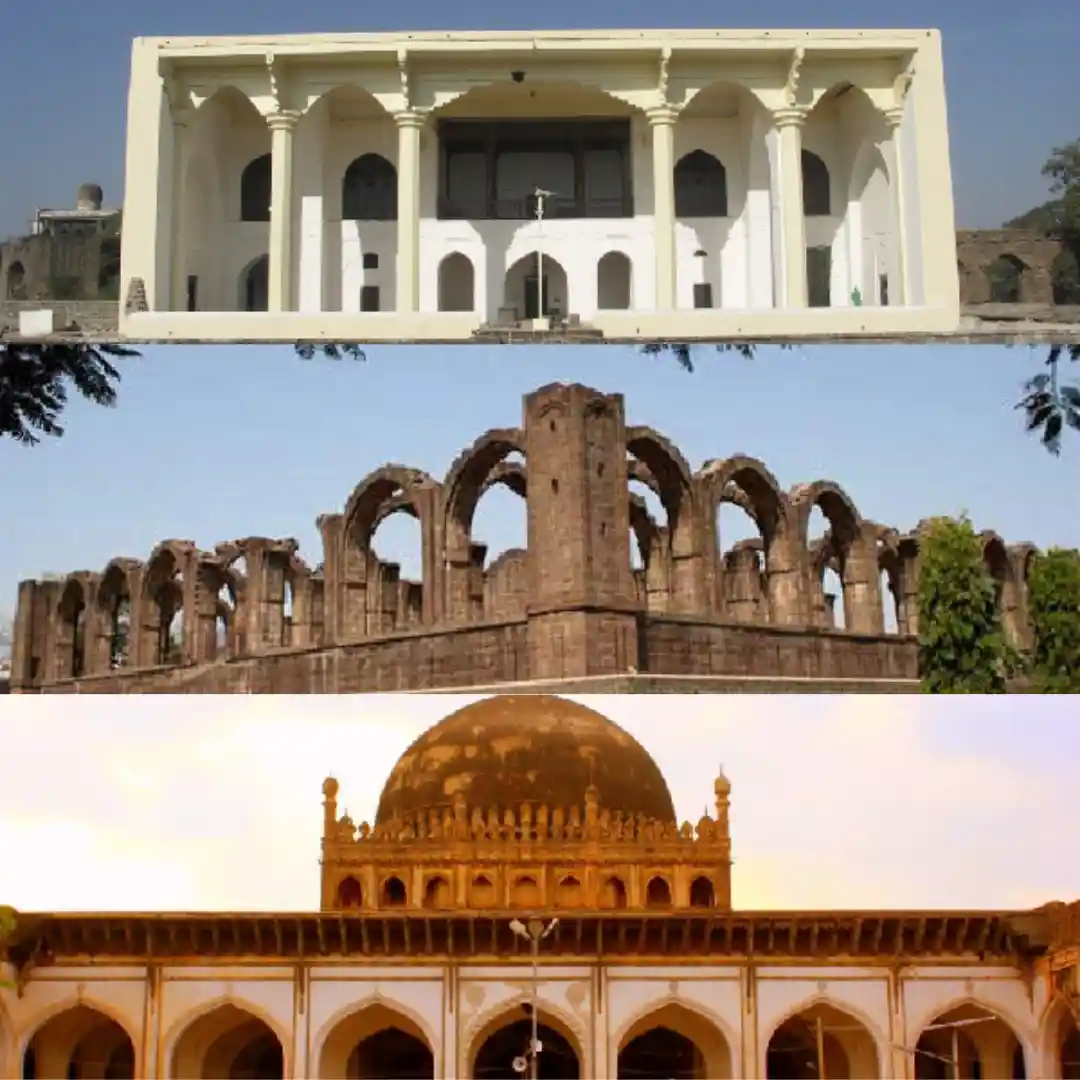Part III-Regal Treats in Deccan Monuments
The tales of the Deccan Sultanates continue in these pages, showcasing more monuments that have adorned the Indian peninsula with the splendours of Indo-Islamic architecture. Some of these structures are glorified in the annals of history and tourism, while others languish in woeful neglect, struggling in their final battle against the ravages of discredit or prejudice. Although capturing the full glory of those bygone days may be akin to imprisoning the entire brightness of the sun in a bottle, the last pages of this series endeavour to convey the essence of those valorous times to future heritage enthusiasts.

Collage created in Canva: Top to Bottom — Bijapur Fort Outer wall and bastions, the Bijapur Fort Cannons and the Jumma Masjid; Source: India a2z.com, Tutorials Point and Wikimedia
The wealth of monuments from the Bijapur dynasty cannot be described in a few lines, and the same is true for the other prominent dynasty among the Deccan Sultanates - the Qutub Shahi dynasty. It is astonishing how destiny intertwines the histories of different nations and kingdoms across the world. The Deccan Sultanates exemplify this statement, starting with the founder of the Saltanat-e-Golkunde or the Persianate Shia-cultured Qutub Shahi dynasty.
The destiny of Quli Qutb-ul-Mulk or Quili Qutub Shah, the Qara Yusuf descendant, led him from the Hamadan province of Iran to Delhi along with his uncle. He later migrated to the Deccan region and rose in rank under the Bahamani dynasty, eventually claiming sovereignty over his province of Golconda when the Bahamanids were dispersed. The dynasty reached great heights after the fall of the Vijayanagara Empire but was often at odds with the Nizam Shahi and Adil Shahi dynasties. The twin capitals of the kingdom, known for housing the largest diamonds in the world, were Hyderabad and Golconda. The Golconda Sultanate ruled the region for 171 years until Aurangzeb annexed the kingdom in the late 17th century.
Memories are like tales captured in forts, religious structures, tombs, palaces, gardens, and more, keeping us enthralled and connected to our ancestral roots. Continuing with the monumental tales of the Bijapur Sultanate, let's take a stroll through the grounds of the Bijapur Fort. The founder, Yusuf Adil Shah, built the Bijapur Fort, a symbol of strength and pride for the Adil Shahi dynasty, with two concentric circles of walls and a 50 feet wide moat. Jean Baptiste Tavernier, the French jeweller who visited Bijapur for trade, recounts:
“the king's palace (Arkillah or citadel) was vast… and the access to it was very dangerous as the ditch with which it was girt was full of crocodiles.”
The city within the walls had a circumference of 400 metres, while the outer walls extended to 10 kilometres and were interspersed with ninety-six bastions, providing spaces for dropping stones or cannons. The fort had five gates, each fortified with ten loaded bastions. Over the course of two centuries, the city of Bijapur was adorned with numerous water systems, hundreds of markets or bazaars, peths (such as Thana Bazaar, Sher Karkhana Bazaar, Salabatpur Peth, Sikandarpur Peth, etc.), fifty masjids, twenty mahals or palaces, and twenty tombs. Travellers like the Dutch Baldeous and the English geographer Ogilby have praised the city for its grandeur, earning it the title of "Agra of the Deccan region.”
“Bijapur was one of the greatest cities in the whole of Asia, more than five ‘'leagues'’ (i.e., fifteen miles)… where most of the traders lived and in Scyanpur (Shahpur) were most of the jewellers dealing in costly pearls.” – Manctelslo or Johan Albrecht de Mandelslo, the German adventurer.
Another exceptional feat of Muhammed Adil Shah was the massive cannon known as the Malik-e-Maidan, located on the Burj-E-Sherz of the Bijapur Fort. The cannon's nozzle opened like the jaws of a lion, with a tiny elephant being crushed between the two fangs. Its construction was unique, producing a tinkling bell sound when tapped, creating a paradox considering the gun's huge size. It was recorded as the largest warhead of medieval times for any kingdom. Additionally, the black-coloured cannon was made of an elemental material that remained cool even under the scorching sun.
Other notable monuments within the fort include the rectangular-shaped Jumma Masjid with forty-five compartments formed with arches, Barakaman, a twelve-arched structure within the Ali Raouza tomb grounds made of black basaltic stones, the three-storeyed Mehtar Masjid with swans and birds carved on its minarets, Saat Manzil Palace with seven storeys (though only five remain intact), and the court hall or palace connected to the fort - Asar Mahal or Dad Mahal, which was originally a shrine to the hairs of Prophet Muhammad.
The heritage of a nation is its greatest wealth, standing the test of time and memories. It is a treasure whose worth grows with each passing generation. Although many monuments within the aforementioned dynasties have fallen into ruin, the historical architectural feats and engineering marvels echo the indomitable spirit of their citadels and reflect the crowning glory in their tombs. While the pages of history may be incomplete, these monuments, built by distinct souls and enshrined in the folklore and local legends of the common people, prevent these flashes in time from fading away with the sunset of age.
The paradox of the name Golconda lies in its origin, deriving from the Telugu phrase Golla Konda, meaning Shepherd's Hill. However, the fort became a hub of the renowned diamond trade due to abundant mines like the Kollur mine, and it housed great vaults to treasure famous diamonds like Koh-i-Noor, Daria-i-Noor, Hope Diamond, Wittelsbach-Graff Diamond, and more. Alongside the Golconda fort, the Charminar stands tall as another marvel of medieval engineering in the history of Nawabi Hyderabad. The monument has become an icon of the Deccan Sultanate and is synonymous with the city where it stands.
Some of the Indo-Persian architectural legacies left behind by the Qutub Shahis include the Golconda Fort, Charminar, royal tombs, Mecca Masjid of Hyderabad, Taramati Baradari, Hayat Bakshi Masjid, Toli Masjid, and many more structures and gardens, including the sixty-six forts boasted by the dynasty. Originally a small granite hilltop outpost fort made of mud by the Kakatiya rulers, the Golconda fort was later fortified into a grand citadel with a circumference of 5 kilometres by the first three Qutub Shahi rulers. The fort complex consisted of an outer wall running for 10 kilometres, secured with semi-circular bastions, each mounted with a cannon. Out of the eighty-seven bastions, only a few remain intact with cannons.
The ramparts protected numerous royal private chambers called kilwat, camel stables, masjids, temples, and more, accessed through four drawbridges and eight gateways. The highest point of the fort is the top pavilion known as Baradari, while the lowest point is the Fateh Darwaza, which features unique and huge iron spikes to prevent elephants from damaging the grand entrance. This entrance is also an engineering wonder with the acoustic ability to echo the sound made under the dome of the entrance at the pavilion on the fort's highest point, warning the fort's inhabitants nearly 1 kilometre away.

Malik-e-Maidan; Source: Tutorials Point

Collage created in Canva: Top-left in a clockwise direction — Fateh Dawarza, Iron spikes on the huge door, Qutub Shahi Tombs and Mecca Masjid; Source: Hyderabad Story Blogspot and Wikimedia

Malik-e-Maidan; Source: Tutorials Point

Collage created in Canva: Charminar of Hyderabad and the famous Golconda Diamonds from top to bottom — Daria-i-Noor, Wittelsbach-Graff Diamond, Hope diamond and Koh-i-Noor; Source: Wikimedia

Collage created in Canva: Top to bottom — Asar Mahal, Barakaman and Mehtar Masjid; Source: Tutorials Point


